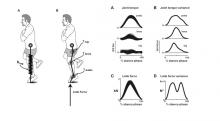
This research was funded by the National Science Foundation to study how humans control their legs and joints to make immediate compensations during locomotion. In this study, Dr. Young-Hui Chang and the Comparative Neuromechanics Lab discovered that during locomotion such as running and hopping, humans generate highly consistent forces on the ground by exploiting their ability to quickly generate numerous combinations of joint torques (high joint variance) that lead to the same leg force (low limb variance).
In this way, biomechanical differences from one step to the next are immediately compensated for at the joint level to maximize the consistency of limb force generation on the ground. Leg forces on the ground are known to be a key determinant of running speed. This ability to use joint coordination to generate consistent forces on the ground, however, appears to decrease at higher speeds, which could become more limiting at sprint speeds. Neuromechanical assessments on athletes to measure joint coordination strategy in sub-maximum running and sprinting could help provide recommendations for reducing potential for overuse injuries and to increase efficiency of sub-maximum and maximum speed running.
